MENU
The Electronic Scholarly Publishing Project: Providing access to classic scientific papers and other scholarly materials, since 1993. More About: ESP | OUR CONTENT | THIS WEBSITE | WHAT'S NEW | WHAT'S HOT
Comparative Timelines
The ESP Timeline (one of the site's most popular features) has been completely updated to allow the user to select (using the timeline controls above each column) different topics for the left and right sides of the display.
Select:
New Left Column
New Left Column
Dates
Decade
New Right Column
New Right Column
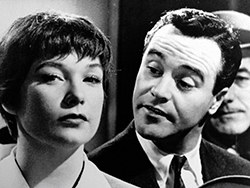 The Apartment wins Academy Award for best picture. After Lost Weekend, Billy Wilder again found himself in the winner's circle, taking home Oscars as producer, director, and co-writer (with I.A.L. Diamond) for this wry look at corporate America.
The Apartment wins Academy Award for best picture. After Lost Weekend, Billy Wilder again found himself in the winner's circle, taking home Oscars as producer, director, and co-writer (with I.A.L. Diamond) for this wry look at corporate America.
1960
DEC released its first mini computer: PDP-1
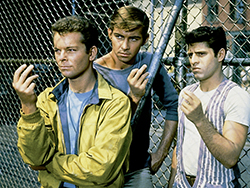 West Side Story wins Academy Award for best picture. The musical was co-directed by Jerome Robbins (who had staged the Broadway musical) and Robert Wise, the first time a team directed a best picture winner. The film won 10 Oscars, remaining in the record books as the sole runner-up to the trio of movies that won 11.
West Side Story wins Academy Award for best picture. The musical was co-directed by Jerome Robbins (who had staged the Broadway musical) and Robert Wise, the first time a team directed a best picture winner. The film won 10 Oscars, remaining in the record books as the sole runner-up to the trio of movies that won 11.
1961
Clive Sinclair founds Sinclair Radionics
Computerized spreadsheets for use in business accounting developed
LEO III completed in 1961
Minivac 601 Computer Launched
Robert Noyce Awarded Patent for "Integrated Circuit"
 Lawrence of Arabia wins Academy Award for best picture. At three hours and 48 minutes, it's the longest-running best picture winner (one minute longer than Gone With the Wind ). The tale of T.E. Lawrence marked the second best picture win for David Lean in five years.
Lawrence of Arabia wins Academy Award for best picture. At three hours and 48 minutes, it's the longest-running best picture winner (one minute longer than Gone With the Wind ). The tale of T.E. Lawrence marked the second best picture win for David Lean in five years.
1962
"Music from Mathematics" LP was created using an IBM 7090 computer
The first commercial Modem manufactured
The Machester Atlas was inaugurated on 7th December 1962
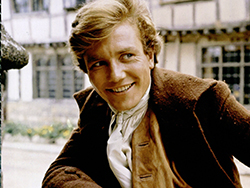 Tom Jones wins Academy Award for best picture. For decades, Hollywood's Hays Code dictated what couldn t be depicted onscreen. This comedy, directed by Tony Richardson and written by John Osborne adapting Henry Fielding, helped break that code by depicting the radical idea that sex could be fun.
Tom Jones wins Academy Award for best picture. For decades, Hollywood's Hays Code dictated what couldn t be depicted onscreen. This comedy, directed by Tony Richardson and written by John Osborne adapting Henry Fielding, helped break that code by depicting the radical idea that sex could be fun.
1963
Douglas Engelbart Invents the Mouse
First edition of the ASCII standard was published.
Theodore H (Ted) Nelson coins the word Hypertext
Kodak introduces the Instamatic.
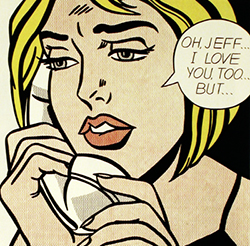 painting by Roy Lichtenstein: Oh, Jeff...I Love You, Too...But... (sometimes Oh, Jeff). Like many of Lichtenstein's works its title comes from the speech balloon in the painting. Although many sources, such as the Encyclopedia of Art, describe Whaam! and Drowning Girl as Lichtenstein's most famous works, artist Vian Shamounki Borchert believes it is this piece, calling it his Mona Lisa. The Daily Mail listed it along with Whaam! and Drowning Girl as one of his most famous at the time of its 2013 Retrospective at the Tate Modern. Borchert notes that this painting captures "the magic" of its "anguished and yes [sic] beautiful blue eyed, blond hair, full lips" female subject while presenting "sad eyes that seem to give in to what seems to be a doomed love affair". Lichtenstein in 1967 Measuring 48 in × 48 inches, Oh, Jeff...I Love You, Too...But... is among the most famous of his early romance comic derivative works from the period when he was adapting cartoons and advertisements into his style via Ben-Day dots.
painting by Roy Lichtenstein: Oh, Jeff...I Love You, Too...But... (sometimes Oh, Jeff). Like many of Lichtenstein's works its title comes from the speech balloon in the painting. Although many sources, such as the Encyclopedia of Art, describe Whaam! and Drowning Girl as Lichtenstein's most famous works, artist Vian Shamounki Borchert believes it is this piece, calling it his Mona Lisa. The Daily Mail listed it along with Whaam! and Drowning Girl as one of his most famous at the time of its 2013 Retrospective at the Tate Modern. Borchert notes that this painting captures "the magic" of its "anguished and yes [sic] beautiful blue eyed, blond hair, full lips" female subject while presenting "sad eyes that seem to give in to what seems to be a doomed love affair". Lichtenstein in 1967 Measuring 48 in × 48 inches, Oh, Jeff...I Love You, Too...But... is among the most famous of his early romance comic derivative works from the period when he was adapting cartoons and advertisements into his style via Ben-Day dots.
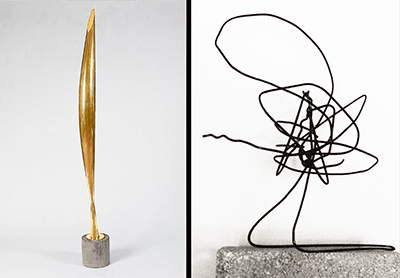 An art exhibit is held at Stanford University, featuring Brancusi's Bird in Space (loaned by student Richard Holkar) as its major piece. Another work entitled Soul in Flight — a "sculpture" consisting of two bent coat hangers — is surreptitiously added to the exhibit by D. Heskett and R. Robbins (student colleagues of Holkar), without the bother of going through the submission process. The coat-hanger piece remains as part of the exhibit for several days, until it is accidentally bumped and comes apart during an evening cleaning of the displays.
An art exhibit is held at Stanford University, featuring Brancusi's Bird in Space (loaned by student Richard Holkar) as its major piece. Another work entitled Soul in Flight — a "sculpture" consisting of two bent coat hangers — is surreptitiously added to the exhibit by D. Heskett and R. Robbins (student colleagues of Holkar), without the bother of going through the submission process. The coat-hanger piece remains as part of the exhibit for several days, until it is accidentally bumped and comes apart during an evening cleaning of the displays.
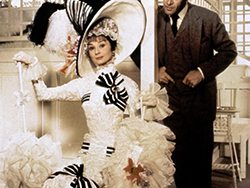 My Fair Lady wins Academy Award for best picture. It was one of the most-anticipated films in years, since it was based on the Broadway mega-hit. The winner of eight Academy Awards, it's also notable as the last best pic winner to be filmed entirely on Hollywood soundstages.
My Fair Lady wins Academy Award for best picture. It was one of the most-anticipated films in years, since it was based on the Broadway mega-hit. The winner of eight Academy Awards, it's also notable as the last best pic winner to be filmed entirely on Hollywood soundstages.
1964
BASIC language developed
First operation of BASIC
First operation of Ferranti Atlas
Graphic tablet developed
IBM releases the System 360 range of commercial computers
Introduction of CDC 6600
Introduction of DEC PDP-7 18-bits minicomputer
First Pentax Spotmatic SLR introduced.
 The Sound of Music wins Academy Award for best picture. A few years after the urban grittiness of West Side Story, Robert Wise directed this wholesome Rodgers & Hammerstein musical. It won five Oscars and was an enormous hit; it also rescued the financially strapped 20th Century Fox, which was recovering from the mega-expensive Cleopatra.
The Sound of Music wins Academy Award for best picture. A few years after the urban grittiness of West Side Story, Robert Wise directed this wholesome Rodgers & Hammerstein musical. It won five Oscars and was an enormous hit; it also rescued the financially strapped 20th Century Fox, which was recovering from the mega-expensive Cleopatra.
1965
Commodore Business Machines (CBM) is founded.
DEC unveils the PDP-8,
Introduction of Wang 300 electronic calculator
Moore's Law coined
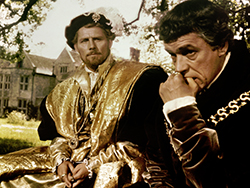 A Man for All Seasons wins Academy Award for best picture. Robert Bolt's thoughtful play, about Sir Thomas More's battles with King Henry VIII, concerned religion, principles, and morality. Bolt adapted his play, which was directed by Fred Zinnemann ( From Here to Eternity ).
A Man for All Seasons wins Academy Award for best picture. Robert Bolt's thoughtful play, about Sir Thomas More's battles with King Henry VIII, concerned religion, principles, and morality. Bolt adapted his play, which was directed by Fred Zinnemann ( From Here to Eternity ).
1966
Introduction of DEC PDP-9
The hand-held pocket calculator was invented at Texas Instruments in 1966
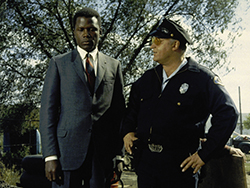 In the Heat of the Night wins Academy Award for best picture. The competition was intense in 1967, including The Graduate and Bonnie & Clyde. But only three years after passage of the Civil Rights Act, this mystery was a look at race relations, exploding prejudices, and offering smart insights. Sidney Poitier and Rod Steiger (best actor winner) led a strong cast.
In the Heat of the Night wins Academy Award for best picture. The competition was intense in 1967, including The Graduate and Bonnie & Clyde. But only three years after passage of the Civil Rights Act, this mystery was a look at race relations, exploding prejudices, and offering smart insights. Sidney Poitier and Rod Steiger (best actor winner) led a strong cast.
1967
Barclays Bank in the UK claims to have installed the first cash dispenser
Elliott Automation merged with English Electric
Introduction of DEC PDP-10
First MOS 10 by 10 active pixel array shown by Noble
 Oliver! wins Academy Award for best picture. The 1960s were NOT the heyday of Hollywood musicals, but you wouldn t know it by looking at Oscar: Oliver! became the fourth musical in eight years to take the best-picture win.
Oliver! wins Academy Award for best picture. The 1960s were NOT the heyday of Hollywood musicals, but you wouldn t know it by looking at Oscar: Oliver! became the fourth musical in eight years to take the best-picture win.
1968
CDC Introduces the 7600 Supercomputer
Douglas C. Engelbart publicly demonstrates the mouse
IBM tests a 8in floppy disc
Integrated Circuits First Used in Apollo Moon shot
Introduction of HP-9100 desk calculator
Robert Noyce and Gordon Moore found Intel Corporation
T J Watson and IBM granted patent for the DRAM
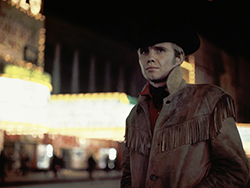 Midnight Cowboy wins Academy Award for best picture. The film, directed by John Schlesinger and starring Jon Voight and Dustin Hoffman, became the first X-rated movie to win the Oscar. When it was re-released two years later, it was re-rated as an R, without any cuts. The script was by Waldo Salt, based on the novel by James Leo Herlihy.
Midnight Cowboy wins Academy Award for best picture. The film, directed by John Schlesinger and starring Jon Voight and Dustin Hoffman, became the first X-rated movie to win the Oscar. When it was re-released two years later, it was re-rated as an R, without any cuts. The script was by Waldo Salt, based on the novel by James Leo Herlihy.
1969
AMD Advanced Micro Devices is founded
ARPANET launch the world's first successful packet-switched wide area computer network
DEC PDP-15 Introduced
First flight to Moon of Apollo XI with Raytheon Apollo Guidance Computer
Honeywell releases the H316 "Kitchen Computer",
Intel announces a 1 kilobit RAM chip
Plessey buys out Ferranti's numerical Control Interests
ESP Quick Facts
ESP Origins
In the early 1990's, Robert Robbins was a faculty member at Johns Hopkins, where he directed the informatics core of GDB — the human gene-mapping database of the international human genome project. To share papers with colleagues around the world, he set up a small paper-sharing section on his personal web page. This small project evolved into The Electronic Scholarly Publishing Project.
ESP Support
In 1995, Robbins became the VP/IT of the Fred Hutchinson Cancer Research Center in Seattle, WA. Soon after arriving in Seattle, Robbins secured funding, through the ELSI component of the US Human Genome Project, to create the original ESP.ORG web site, with the formal goal of providing free, world-wide access to the literature of classical genetics.
ESP Rationale
Although the methods of molecular biology can seem almost magical to the uninitiated, the original techniques of classical genetics are readily appreciated by one and all: cross individuals that differ in some inherited trait, collect all of the progeny, score their attributes, and propose mechanisms to explain the patterns of inheritance observed.
ESP Goal
In reading the early works of classical genetics, one is drawn, almost inexorably, into ever more complex models, until molecular explanations begin to seem both necessary and natural. At that point, the tools for understanding genome research are at hand. Assisting readers reach this point was the original goal of The Electronic Scholarly Publishing Project.
ESP Usage
Usage of the site grew rapidly and has remained high. Faculty began to use the site for their assigned readings. Other on-line publishers, ranging from The New York Times to Nature referenced ESP materials in their own publications. Nobel laureates (e.g., Joshua Lederberg) regularly used the site and even wrote to suggest changes and improvements.
ESP Content
When the site began, no journals were making their early content available in digital format. As a result, ESP was obliged to digitize classic literature before it could be made available. For many important papers — such as Mendel's original paper or the first genetic map — ESP had to produce entirely new typeset versions of the works, if they were to be available in a high-quality format.
ESP Help
Early support from the DOE component of the Human Genome Project was critically important for getting the ESP project on a firm foundation. Since that funding ended (nearly 20 years ago), the project has been operated as a purely volunteer effort. Anyone wishing to assist in these efforts should send an email to Robbins.
ESP Plans
With the development of methods for adding typeset side notes to PDF files, the ESP project now plans to add annotated versions of some classical papers to its holdings. We also plan to add new reference and pedagogical material. We have already started providing regularly updated, comprehensive bibliographies to the ESP.ORG site.
ESP Picks from Around the Web (updated 06 MAR 2017 )
Old Science

Weird Science

Treating Disease with Fecal Transplantation
Fossils of miniature humans (hobbits) discovered in Indonesia

Dinosaur tail, complete with feathers, found preserved in amber.
Astronomy

Mysterious fast radio burst (FRB) detected in the distant universe.